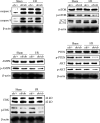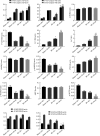Leptin relieves ischemia/reperfusion induced acute kidney injury through inhibiting apoptosis and autophagy
- PMID: 35545358
- PMCID: PMC10930488
- DOI: 10.11817/j.issn.1672-7347.2022.210244
Leptin relieves ischemia/reperfusion induced acute kidney injury through inhibiting apoptosis and autophagy
Abstract
Objectives: Acute kidney injury (AKI) can be caused by ischemia/reperfusion (I/R), nephrotoxin, and sepsis, with poor prognosis and high mortality. Leptin is a protein molecule that regulates the body's energy metabolism and reproductive activities via binding to its specific receptor. Leptin can inhibit cardiomyocyte apoptosis caused by I/R, but its effect on I/R kidney injury and the underlying mechanisms are still unclear. This study aims to investigate the effect and mechanisms of leptin on renal function, renal histopathology, apoptosis, and autophagy during acute I/R kidney injury.
Methods: Healthy adult male mice were randomly divided into 4 groups: a sham+wild-type mice (ob/+) group, a sham+leptin gene-deficient mice (ob/ob) group, an I/R+ob/+ group, and an I/R+ob/ob group (n=8 per group). For sham operation, a longitudinal incision was made on the back of the mice to expose and separate the bilateral kidneys and renal arteries, and no subsequent treatment was performed. I/R treatment was ischemia for 30 min and reperfusion for 48 h. The levels of BUN and SCr were detected to evaluate renal function; HE staining was used to observe the pathological changes of renal tissue; TUNEL staining was used to observe cell apoptosis, and apoptosis-positive cells were counted; Western blotting was used to detect levels of apoptosis-related proteins (caspase 3, caspase 9), autophagy-related proteins [mammalian target of rapamycin (mTOR), phosphorylated mTOR (p-mTOR), LC3 I, LC3 II], mTOR-dependent signaling pathway proteins [phosphate and tension homology (PTEN), adenosine monophosphate-activated protein kinase (AMPK), protein kinase B (AKT), extracellular regulated protein kinase (ERK), phosphorylated PTEN (p-PTEN), phosphorylated AMPK (p-AMPK), phosphorylated AKT (p-AKT), phosphorylated ERK (p-ERK)].
Results: There was no significant difference in the levels of BUN and SCr between the sham+ob/+ group and the sham+ob/ob group (both P>0.05). The levels of BUN and SCr in the I/R+ob/+ group were significantly higher than those in the sham+ob/+ group (both P<0.05). Compared with the mice in the sham+ob/ob group or the I/R+ob/+ group, the levels of BUN and SCr in the I/R+ob/ob group were significantly increased (all P<0.05). There was no obvious damage to the renal tubules in the sham+ob/+ group and the sham+ob/ob group. Compared with sham+ob/+ group and sham+ob/ob group, both the I/R+ob/+ group and the I/R+ob/ob group had cell damage such as brush border shedding, vacuolar degeneration, and cast formation. Compared with the I/R+ob/+ group, the renal tubules of the mice in the I/R+ob/ob group were more severely damaged. The pathological score of renal tubular injury showed that the renal tubular injury was the most serious in the I/R+ob/ob group (P<0.05). Compared with the sham+ob/+ group, the protein levels of caspase 3, caspase 9, PTEN, and LC3 II were significantly up-regulated, the ratio of LC3 II to LC3 I was significantly increased, and the protein levels of p-mTOR, p-PTEN, p-AMPK, p-AKT, and p-ERK were significantly down-regulated in the I/R+ob/+ group (all P<0.05). Compared with the sham+ob/ob group, the protein levels of caspase 3, caspase 9, PTEN, and LC3 II were significantly up-regulated, and the ratio of LC3 II to LC3 I was significantly increased, while the protein levels of p-mTOR, p-PTEN, p-AMPK, p-AKT, and p-ERK were significantly down-regulated in the I/R+ob/ob group (all P<0.05). Compared with the I/R+ob/+ group, the levels of p-mTOR, p-PTEN, p-AMPK, p-AKT were more significantly down-regulated, while the levels of caspase 3, caspase 9, PTEN, and LC3 II were more significantly up-regulated, and the ratio of LC3 II to LC3 I was more significantly increase in the I/R+ob/ob group (all P<0.05).
Conclusions: Renal function and tubular damage, and elevated levels of apoptosis and autophagy are observed in mice kidneys after acute I/R. Leptin might relieve I/R induced AKI by inhibiting apoptosis and autophagy that through a complex network of interactions between mTOR-dependent signaling pathways.
目的: 急性肾损伤(acute kidney injury,AKI)可由缺血再灌注(ischemia/reperfusion,I/R)、肾毒素和败血症等引起,预后差,病死率高。瘦素(leptin)是一种蛋白质分子,主要通过与其特异性受体结合来调节机体能量代谢和生殖活动。Leptin可抑制I/R损伤导致的心肌细胞凋亡,但其对I/R肾损伤的影响及其机制尚不明确。本研究旨在探讨leptin在急性I/R肾损伤过程中对肾功能、肾组织病理、细胞凋亡和自噬的影响及其机制。方法: 将健康成年雄性小鼠随机分为4组:假手术(sham)+野生型小鼠(ob/+)组、sham+leptin基因缺陷型小鼠(ob/ob)组、I/R+ob/+组、I/R+ob/ob组,每组8只。假手术处理为在小鼠背部做纵向切口,暴露、分离双侧肾及肾动脉,不作后续处理。I/R处理为缺血30 min,再灌注48 h。检测BUN和SCr水平以评价肾功能;采用HE染色观察肾组织病理变化;采用TUNEL染色观察细胞凋亡,计数凋亡阳性细胞;采用蛋白质印迹法检测小鼠凋亡相关蛋白质(caspase 3、caspase 9),自噬相关蛋白质[哺乳动物雷帕霉素靶蛋白(mammalian target of rapamycin,mTOR)、磷酸化的mTOR(p-mTOR)、LC3 I、LC3 II],mTOR依赖的信号通路蛋白质[磷酸酯酶与张力蛋白同源物(phosphate and tension homology,PTEN)、腺苷单磷酸活化蛋白激酶(adenosine monophosphate-activated protein kinase,AMPK)、蛋白激酶B(protein kinase B,AKT)、细胞外调节蛋白激酶(extracellular regulated protein kinase,ERK)、磷酸化的PTEN(p-PTEN)、磷酸化的AMPK(p-AMPK)、磷酸化的AKT(p-AKT)、磷酸化的ERK(p-ERK)]的表达水平。结果: Sham+ob/+组与sham+ob/ob组小鼠的BUN和SCr水平差异均无统计学意义(均P>0.05)。I/R+ob/+组小鼠的BUN和SCr水平较sham+ob/+组小鼠均显著上升(均P<0.05),I/R+ob/ob组小鼠的BUN和SCr水平较sham+ob/ob组和I/R+ob/+组小鼠均显著上升(均P<0.05)。Sham+ob/+组与sham+ob/ob组小鼠肾小管无明显损伤。与sham+ob/+组和sham+ob/ob组相比,I/R+ob/+组和I/R+ob/ob组均出现肾小管上皮细胞刷状缘脱落、空泡变性和蛋白管型形成等细胞损伤表现。与I/R+ob/+组相比,I/R+ob/ob组小鼠肾小管受损更严重。肾小管损伤病理评分结果显示I/R+ob/ob组小鼠肾小管损伤最严重(P<0.05)。与sham+ob/+组相比,I/R+ob/+组的caspase 3、caspase 9、PTEN和LC3 II蛋白质水平明显上调,LC3 II/LC3 I比值明显升高,p-mTOR、p-PTEN、p-AMPK、p-AKT和p-ERK蛋白质表达水平明显下调(均P<0.05);与sham+ob/ob组相比,I/R+ob/ob组的caspase 3、caspase 9、PTEN和LC3 II蛋白质表达水平明显上调,LC3 II/LC3 I比值明显升高,而p-mTOR、p-PTEN、p-AMPK、p-AKT和p-ERK蛋白质表达水平明显下调(均P<0.05);且与I/R+ob/+组相比,I/R+ob/ob组的p-mTOR、p-PTEN、p-AMPK、p-AKT和p-ERK蛋白质表达水平下调更明显,caspase 3、caspase 9、PTEN、LC3 II蛋白质表达水平上调更明显,LC3 II/LC3 I比值升高更明显(均P<0.05)。结论: 小鼠肾急性I/R后出现肾功能和肾小管损伤,凋亡和自噬水平升高。Leptin可能通过抑制凋亡和mTOR依赖的信号通路相互作用构成的复杂网络调控自噬减轻肾急性 I/R损伤。.
Keywords: acute kidney injury; apoptosis; autophagy; ischemia/reperfusion; leptin.
Conflict of interest statement
作者声称无任何利益冲突。
Figures






Similar articles
-
The roles of AMPK/mTOR autophagy pathway in the acute kidney injury-induced acute lung injury.Chin J Physiol. 2023 Mar-Apr;66(2):73-84. doi: 10.4103/cjop.CJOP-D-22-00122. Chin J Physiol. 2023. PMID: 37082995
-
Apoptosis repressor with caspase recruitment domain deficiency accelerates ischemia/reperfusion (I/R)-induced acute kidney injury by suppressing inflammation and apoptosis: The role of AKT/mTOR signaling.Biomed Pharmacother. 2019 Apr;112:108681. doi: 10.1016/j.biopha.2019.108681. Epub 2019 Mar 1. Biomed Pharmacother. 2019. PMID: 30970510
-
Protective Mechanism of Cordyceps sinensis Treatment on Acute Kidney Injury-Induced Acute Lung Injury through AMPK/mTOR Signaling Pathway.Chin J Integr Med. 2023 Oct;29(10):875-884. doi: 10.1007/s11655-023-3593-4. Epub 2023 Feb 27. Chin J Integr Med. 2023. PMID: 36843056
-
Pharmacological modulation of PI3K/PTEN/Akt/mTOR/ERK signaling pathways in ischemic injury: a mechanistic perspective.Metab Brain Dis. 2025 Feb 26;40(3):131. doi: 10.1007/s11011-025-01543-8. Metab Brain Dis. 2025. PMID: 40009091 Review.
-
Autophagy Function and Regulation in Kidney Disease.Biomolecules. 2020 Jan 7;10(1):100. doi: 10.3390/biom10010100. Biomolecules. 2020. PMID: 31936109 Free PMC article. Review.
Cited by
-
Endocrinological disorders in acute kidney injury: an often overlooked field of clinical research.J Nephrol. 2023 Apr;36(3):885-893. doi: 10.1007/s40620-022-01554-z. Epub 2023 Jan 18. J Nephrol. 2023. PMID: 36652168 Review.
-
Preoperative leptin levels were associated with postoperative acute kidney injury in patients with acute type A aortic dissection.Ren Fail. 2024 Dec;46(2):2433152. doi: 10.1080/0886022X.2024.2433152. Epub 2025 Jan 20. Ren Fail. 2024. PMID: 39832788 Free PMC article.
References
MeSH terms
Substances
Grants and funding
LinkOut - more resources
Full Text Sources
Research Materials
Miscellaneous

